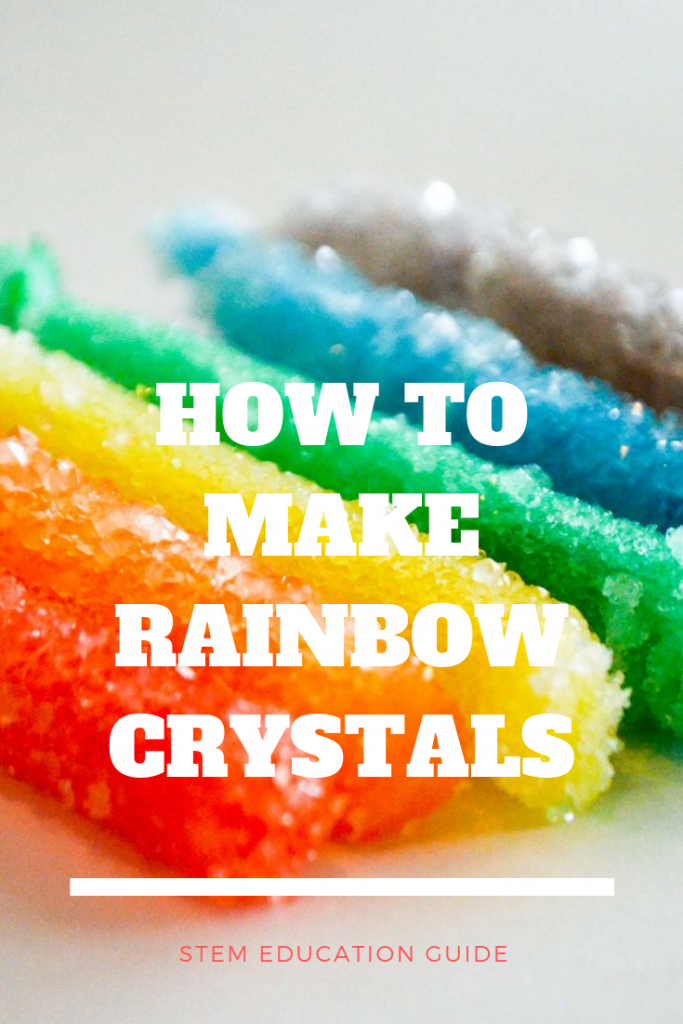Creating crystals is one of my favorite science experiments!
I used to make borax crystal Christmas ornaments when I was a kid too, so this may be one of my longest standing science experiments!
Borax makes the best crystals! They are large and form quickly overnight, so its great if your kids (or you!) are impatient to see the crystals form.
I had an idea that we could put a spin on the borax Christmas ornaments experiment and instead create rainbow crystals to hang in the window as a great spring time STEM activity to welcome the warm weather.

Table of Contents
What is Borax?
Borax is the main ingredient to form your crystals. Borax is an important boron compound, also known as sodium borate.
It has a lot of uses! Among the most common, borax is a laundry booster and detergent. You can find at any grocery store or super market in the detergent aisle.
Borax doesn’t dissolve well in cold water, but it’s solubility increases as water temperature increases, which is very important for our science experiment below!

What is a crystal?
A crystal is a type of solid with flat sides and symmetrical shape because the molecules bond together in specific, repeatable pattern.
There are many examples of crystals around us! Sugar, salt, and many gemstones like diamonds are all examples of crystals.
In this science experiment, we’re looking at borax crystals! Once you create your crystals, exam the pattern. Does it repeat? What type of shape is it? How does it compare to other crystals you have seen?
How do borax crystals form?
As mentioned above, hot water can hold more borax than cold water. This is because when water is heated, the molecules spread out and makes more room for the borax.
When you mixed the hot water with borax, you created a suspension.
A suspension is a mixture of solid and liquid particles. In order to be a suspension, the particles can not fully dissolve and will settle out over time.
You’ll notice when you create your borax mixture that the water is still cloudy.
As the water begins to cool, the water molecules begin to move closer together and makes less space for the borax. This is beginning the process of crystallization.
The borax molecules in the gather together to bond with other borax on nucleation sites such as bumps or cracks, and in this case – your pipe cleaner!
They do this in a uniform and repeating pattern, and this pattern forms the crystal.


How to Make Rainbow Crystals
You can make these rainbow crystals with just a few supplies, and then they make beautiful decorations for art projects around the house! Best part — you’ll see beautiful, large crystals after just a single night.
Ingredients
- 1 1/8 cups of Borax
- 6 cups boiling water
- Food coloring (15 to 20 drops per jar)
- String
- White pipe cleaners
- Glass jars
- Chopsticks, pencils or sticks

Directions
- Bring 6 cups of water to boil.
- Stir in 1 1/8 cups (or 18 tablespoons) of borax into the water. If you’re making a bigger batch or have larger containers that you need to fill, the ratio of borax to water should be at least 3 tablespoons per 1 cup of water. If you don’t have a very saturated liquid, your crystals won’t form as well. So its better to have a bit more borax in your mixture than not enough.
- Stir the borax in the hot water until the water is slightly cloudy and there is no longer borax settled at the bottom.
- Pour the borax into your jars or other glass container. (Note: glass will work better than plastic, as the liquid cools slower in glass than in plastic.)
- Add 15- 20 drops of food coloring to each jar. You should use a lot of food coloring for dramatic colors.
- Tie your pipe cleaners to a string and connect to a chopstick or pencil.
- Hang your stick over the rim of the jar with pipe cleaner in your borax solution.
- Sit back and wait — your crystals are now forming! Let your jars rest overnight and then inspect your crystals.
- Take your crystals out of the jar and set to dry on a paper towel.
- It’s your choice what you do with your crystals next! We tied ours to a stick to hang in the window as a beautiful spring-time sun catcher!

Helpful Tips
- As mentioned above, it’s really important that you have a very saturated solution. The minimum ratio of borax to water should be 3 tablespoons of borax per 1 cup of water.
- Clean up: You’ll see that borax will settle and crystalize at the bottom of your jar too. Just fill your jars up with hot water. You’ll be able to break up the borax off the bottom of the jars. I put the largest pieces in the trash, and washed the rest down the sink. Then wash the jars in the dishwasher.
- Are the strings and sticks really necessary? Yes! Use the string so the pipe cleaners don’t touch the bottom or lean against the side of the glass. When you try to take them out, they can stick and break apart.
- Make sure your pipe cleaners are fully covered with the borax solution.

Wrapping Up
We hope you love our rainbow crystal science experiment as much as we do! We’d love to hear what you create with your beautiful crystals. They make great tree ornaments or sun catchers. Just make sure you don’t put them anywhere where they could get wet.
Want to create your own experiments with different amounts of water or borax? Check out our free scientific method worksheet for a guide to conduct your experiment!









amazing experiment
just one question: can you make them with another compound that is not toxic?